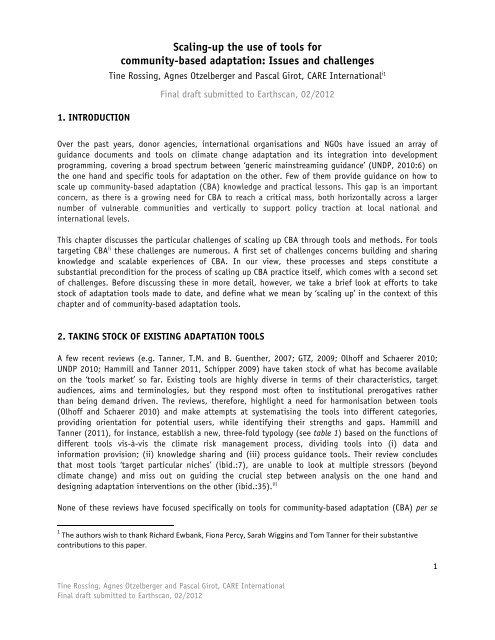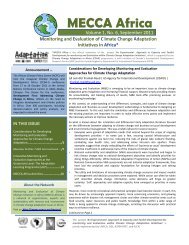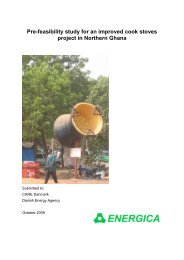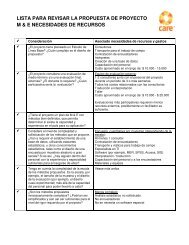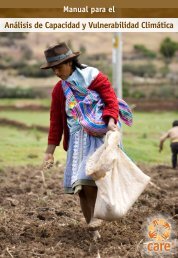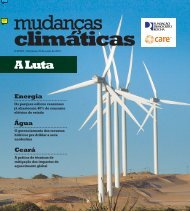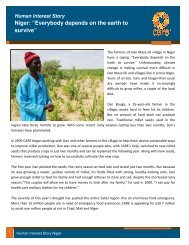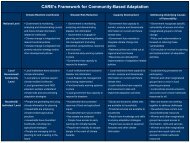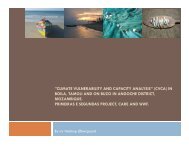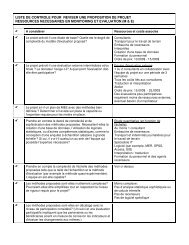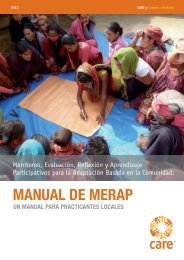Scaling-up the use of tools for community-based adaptation: Issues ...
Scaling-up the use of tools for community-based adaptation: Issues ...
Scaling-up the use of tools for community-based adaptation: Issues ...
You also want an ePaper? Increase the reach of your titles
YUMPU automatically turns print PDFs into web optimized ePapers that Google loves.
1. INTRODUCTION<br />
<strong>Scaling</strong>-<strong>up</strong> <strong>the</strong> <strong>use</strong> <strong>of</strong> <strong>tools</strong> <strong>for</strong><br />
<strong>community</strong>-<strong>based</strong> <strong>adaptation</strong>: <strong>Issues</strong> and challenges<br />
Tine Rossing, Agnes Otzelberger and Pascal Girot, CARE International i1<br />
Final draft submitted to Earthscan, 02/2012<br />
Over <strong>the</strong> past years, donor agencies, international organisations and NGOs have issued an array <strong>of</strong><br />
guidance documents and <strong>tools</strong> on climate change <strong>adaptation</strong> and its integration into development<br />
programming, covering a broad spectrum between ‘generic mainstreaming guidance’ (UNDP, 2010:6) on<br />
<strong>the</strong> one hand and specific <strong>tools</strong> <strong>for</strong> <strong>adaptation</strong> on <strong>the</strong> o<strong>the</strong>r. Few <strong>of</strong> <strong>the</strong>m provide guidance on how to<br />
scale <strong>up</strong> <strong>community</strong>-<strong>based</strong> <strong>adaptation</strong> (CBA) knowledge and practical lessons. This gap is an important<br />
concern, as <strong>the</strong>re is a growing need <strong>for</strong> CBA to reach a critical mass, both horizontally across a larger<br />
number <strong>of</strong> vulnerable communities and vertically to s<strong>up</strong>port policy traction at local national and<br />
international levels.<br />
This chapter discusses <strong>the</strong> particular challenges <strong>of</strong> scaling <strong>up</strong> CBA through <strong>tools</strong> and methods. For <strong>tools</strong><br />
targeting CBA ii <strong>the</strong>se challenges are numerous. A first set <strong>of</strong> challenges concerns building and sharing<br />
knowledge and scalable experiences <strong>of</strong> CBA. In our view, <strong>the</strong>se processes and steps constitute a<br />
substantial precondition <strong>for</strong> <strong>the</strong> process <strong>of</strong> scaling <strong>up</strong> CBA practice itself, which comes with a second set<br />
<strong>of</strong> challenges. Be<strong>for</strong>e discussing <strong>the</strong>se in more detail, however, we take a brief look at ef<strong>for</strong>ts to take<br />
stock <strong>of</strong> <strong>adaptation</strong> <strong>tools</strong> made to date, and define what we mean by ‘scaling <strong>up</strong>’ in <strong>the</strong> context <strong>of</strong> this<br />
chapter and <strong>of</strong> <strong>community</strong>-<strong>based</strong> <strong>adaptation</strong> <strong>tools</strong>.<br />
2. TAKING STOCK OF EXISTING ADAPTATION TOOLS<br />
A few recent reviews (e.g. Tanner, T.M. and B. Guen<strong>the</strong>r, 2007; GTZ, 2009; Olh<strong>of</strong>f and Schaerer 2010;<br />
UNDP 2010; Hammill and Tanner 2011, Schipper 2009) have taken stock <strong>of</strong> what has become available<br />
on <strong>the</strong> ‘<strong>tools</strong> market’ so far. Existing <strong>tools</strong> are highly diverse in terms <strong>of</strong> <strong>the</strong>ir characteristics, target<br />
audiences, aims and terminologies, but <strong>the</strong>y respond most <strong>of</strong>ten to institutional prerogatives ra<strong>the</strong>r<br />
than being demand driven. The reviews, <strong>the</strong>re<strong>for</strong>e, highlight a need <strong>for</strong> harmonisation between <strong>tools</strong><br />
(Olh<strong>of</strong>f and Schaerer 2010) and make attempts at systematising <strong>the</strong> <strong>tools</strong> into different categories,<br />
providing orientation <strong>for</strong> potential <strong>use</strong>rs, while identifying <strong>the</strong>ir strengths and gaps. Hammill and<br />
Tanner (2011), <strong>for</strong> instance, establish a new, three-fold typology (see table 1) <strong>based</strong> on <strong>the</strong> functions <strong>of</strong><br />
different <strong>tools</strong> vis-à-vis <strong>the</strong> climate risk management process, dividing <strong>tools</strong> into (i) data and<br />
in<strong>for</strong>mation provision; (ii) knowledge sharing and (iii) process guidance <strong>tools</strong>. Their review concludes<br />
that most <strong>tools</strong> ‘target particular niches’ (ibid.:7), are unable to look at multiple stressors (beyond<br />
climate change) and miss out on guiding <strong>the</strong> crucial step between analysis on <strong>the</strong> one hand and<br />
designing <strong>adaptation</strong> interventions on <strong>the</strong> o<strong>the</strong>r (ibid.:35). iii<br />
None <strong>of</strong> <strong>the</strong>se reviews have foc<strong>use</strong>d specifically on <strong>tools</strong> <strong>for</strong> <strong>community</strong>-<strong>based</strong> <strong>adaptation</strong> (CBA) per se<br />
1 The authors wish to thank Richard Ewbank, Fiona Percy, Sarah Wiggins and Tom Tanner <strong>for</strong> <strong>the</strong>ir substantive <br />
contributions to this paper. <br />
<br />
1 <br />
Tine Rossing, Agnes Otzelberger and Pascal Girot, CARE International<br />
Final draft submitted to Earthscan, 02/2012
or addressed <strong>the</strong> challenges related to applying <strong>the</strong>se <strong>tools</strong> <strong>for</strong> scaling <strong>up</strong> <strong>community</strong>-<strong>based</strong> <strong>adaptation</strong>,<br />
which is <strong>the</strong> focus <strong>of</strong> this chapter. CBA is still a relatively recent and rapidly evolving field, and, as<br />
such, is undergoing an iterative learning process within <strong>the</strong> global CBA <strong>community</strong>, where knowledge<br />
about <strong>adaptation</strong> grows <strong>based</strong> on practice (Huq 2011). At present, many <strong>of</strong> its <strong>tools</strong> are limited in scope<br />
or types <strong>of</strong> risk <strong>the</strong>y take into account, and <strong>the</strong> scale <strong>of</strong> <strong>the</strong>ir application is <strong>of</strong>ten restricted to<br />
ho<strong>use</strong>holds or communities, providing only limited guidance on how to engage with broader governance<br />
structures and contexts.<br />
Table 1: Categories <strong>of</strong> climate risk management and <strong>adaptation</strong> <strong>tools</strong><br />
Type / characteristics Notes Examples from <strong>the</strong> development <strong>community</strong><br />
1. Process guidance <strong>tools</strong><br />
Tools that guide <strong>use</strong>rs through <strong>the</strong><br />
identification, ga<strong>the</strong>ring, and analysis <strong>of</strong><br />
relevant data and in<strong>for</strong>mation to:<br />
• Identify climate risks to<br />
development activities (<strong>of</strong>ten using<br />
Type 2 <strong>tools</strong>)<br />
• Assess and analyse climate risk<br />
management strategies<br />
• Evaluate option to integrate<br />
climate risk management into<br />
development activities<br />
These <strong>tools</strong> can guide <strong>use</strong>rs<br />
through <strong>the</strong> entire<br />
CRM/<strong>adaptation</strong> process (e.g.<br />
from awareness-raising to<br />
monitoring and evaluation), or<br />
just one or several steps in <strong>the</strong><br />
process (e.g. assessing current<br />
and future climate risk). The<br />
majority are available as<br />
documents (e.g. booklets,<br />
reports), although some are<br />
available as computer<br />
programs.<br />
• Adapting to Coastal Climate Change: A Guidebook<br />
<strong>for</strong> Development Planners<br />
www.crc.uri.edu/index.phpactid=366<br />
• BMZ Environment and Climate Assessment<br />
www.gtz.de/climate-check<br />
• CEDRA:<br />
http://tilz.tearfund.org/Topics/Environmental+Sus<br />
tainability/CEDRA.htm<br />
• CRiSTAL: www.cristaltool.org<br />
• ORCHID: www.ids.ac.uk/climatechange/orchid<br />
• USAID Guidance Manual:<br />
http://www.usaid.gov/our_work/environment/cli<br />
mate/policies_prog/<strong>adaptation</strong>.html<br />
2. Data and in<strong>for</strong>mation provision <strong>tools</strong><br />
These <strong>tools</strong> generate or present data and<br />
in<strong>for</strong>mation on:<br />
• Primary climate variables and<br />
projections (e.g. temperature,<br />
rainfall trends)<br />
• Secondary climate impacts (e.g.<br />
flood maps, crop yields)<br />
• Vulnerability and response options<br />
(e.g. poverty maps, example<br />
<strong>adaptation</strong> options)<br />
These <strong>tools</strong> tend to depend on<br />
some computer capacity, and a<br />
growing number on Internet<br />
access. They tend to be<br />
databases, modelling programs,<br />
mapping and visualisation<br />
<strong>tools</strong>.<br />
• CI-Grasp www.ci-grasp.org<br />
• Climate Wizard: www.climatewizard.org<br />
• Climate Change Explorer Tool:<br />
www.weadapt.org/wiki/The_Climate_Change_Expl<br />
orer_Tool<br />
• PRECIS: www.precis.met<strong>of</strong>fice.com<br />
• SERVIR: www.servir.net<br />
• World Bank CC Knowledge Portal: climate, impact<br />
and scoio-economic data<br />
http://sdwebx.worldbank.org/climateportal/<br />
3. Knowledge-sharing <strong>tools</strong><br />
Plat<strong>for</strong>ms and networks that <strong>of</strong>fer<br />
<strong>adaptation</strong> practitioners a virtual space<br />
<strong>for</strong> in<strong>for</strong>mation and experiences related<br />
to climate risk and <strong>adaptation</strong>. These<br />
spaces allow <strong>use</strong>rs to:<br />
• Ho<strong>use</strong> or store in<strong>for</strong>mation and<br />
knowledge<br />
• Share it with o<strong>the</strong>r interested <strong>use</strong>rs<br />
• Interact with o<strong>the</strong>r <strong>use</strong>rs to develop<br />
or advance ideas, approaches,<br />
<strong>tools</strong>, monitoring etc.<br />
Typically knowledge plat<strong>for</strong>ms,<br />
increasingly reliant on Web 2.0<br />
functionality and <strong>use</strong>rgenerated<br />
content. They can be<br />
important <strong>for</strong> validation <strong>of</strong> Type<br />
1 and Type 2 <strong>tools</strong>, as <strong>the</strong>se<br />
plat<strong>for</strong>ms can <strong>of</strong>fer a space <strong>for</strong><br />
<strong>use</strong>r feedback and <strong>of</strong>fer some<br />
sort <strong>of</strong> quality control<br />
mechanism. They also help to<br />
build a <strong>community</strong> <strong>of</strong> practice<br />
around climate change<br />
<strong>adaptation</strong>.<br />
• Adaptation Learning Mechanism:<br />
www.<strong>adaptation</strong>learning.net<br />
• AfricaAdapt: www.africa-adapt.net<br />
• Climate Adaptation Knowledge Exchange:<br />
www.cakex.org<br />
• Climate One Stop:<br />
http://arcserver4.iagt.org/climate1stop/<br />
• ELDIS resource guide on Adaptation:<br />
www.eldis.org/go/topics/dossiers/climatechange-<strong>adaptation</strong><br />
• weADAPT plat<strong>for</strong>m: www.weadapt.org<br />
• World Bank CC Knowledge Portal:<br />
http://sdwebx.worldbank.org/climateportal/<br />
Source: Hammill & Tanner 2011<br />
<br />
2 <br />
Tine Rossing, Agnes Otzelberger and Pascal Girot, CARE International<br />
Final draft submitted to Earthscan, 02/2012
3. DEFINING SCALING UP AND SCALING ‘OUT’<br />
‘<strong>Scaling</strong> <strong>up</strong>’ <strong>community</strong>-<strong>based</strong> <strong>adaptation</strong> can encompass a variety <strong>of</strong> processes that are both vertical<br />
and horizontal in nature. Upscaling or vertical scale-<strong>up</strong>, firstly, concerns <strong>the</strong> notion <strong>of</strong> scaling <strong>up</strong> from<br />
<strong>the</strong> local or <strong>community</strong> level to higher levels <strong>of</strong> decision making (such as sub-regional or national)<br />
within a given country or globally. iv To date, <strong>up</strong>scaling climate <strong>adaptation</strong> in general has mainly been<br />
addressed through mainstreaming climate change into sectoral policies and primarily carried out at <strong>the</strong><br />
national level, as a top-down strategy. One plausible explanation could be that implementation <strong>of</strong> CBA is<br />
still gaining ground, as most ef<strong>for</strong>ts to date have foc<strong>use</strong>d on CBA planning. While one challenge <strong>for</strong> CBA<br />
in this top-down process has been and still is <strong>the</strong> availability <strong>of</strong> down-scaled climate data to in<strong>for</strong>m<br />
local-level <strong>adaptation</strong> strategies (Birkmann et al. 2009; 30), ‘<strong>up</strong>scaling’ reverses this top-down trend in<br />
relying on lessons learned from local change processes to in<strong>for</strong>m decision-making at higher<br />
administrative and organisational levels with wider-reaching impact (Larsen et al., 2011:v). As such, in<br />
<strong>the</strong>ory, CBA <strong>tools</strong> can facilitate <strong>the</strong> process <strong>of</strong> scaling <strong>up</strong> CBA if <strong>the</strong>y help building experience and<br />
documenting good practices that result in appropriate <strong>adaptation</strong> decisions at higher levels. Burton also<br />
links <strong>the</strong> scaling <strong>up</strong> process to a need <strong>for</strong> enhanced integration <strong>of</strong> CBA into <strong>the</strong> wider development<br />
processes, highlighting <strong>the</strong> importance <strong>of</strong> avoiding stand-alone <strong>adaptation</strong> initiatives (Burton 2011).<br />
Secondly, CBA can also be expanded over a larger geographical area, which can be defined as ‘scaling<br />
out.’ Such a horizontal scale-<strong>up</strong> process could involve a small-scale project intervention or initiative, <strong>the</strong><br />
scope <strong>of</strong> which is broadened into a larger-scale endeavour (Snapp and Heong, 2003). The expansion<br />
could involve a larger number <strong>of</strong> new but replicated <strong>community</strong>-<strong>based</strong> initiatives <strong>based</strong> on <strong>the</strong> initial<br />
intervention. It could also involve a larger number <strong>of</strong> beneficiaries or a whole region as opposed to one<br />
or a few targeted communities. v<br />
Tools aimed at s<strong>up</strong>porting such processes, <strong>the</strong>re<strong>for</strong>e, need to allow <strong>for</strong> replication <strong>of</strong> CBA across<br />
different contexts or with larger outreach (horizontal and/or vertical), while remaining both contextappropriate<br />
and coordinated with wider policy, legislative, planning and budgeting frameworks needed<br />
to sustain such outcomes at scale and over time. vi As Brooks et al (2011:7) well point out, such <strong>tools</strong><br />
will also need to consider:<br />
The long timescales over which many aspects <strong>of</strong> climate change (and hence much<br />
<strong>adaptation</strong>) will unfold, and <strong>the</strong> problems <strong>of</strong> how to evaluate <strong>the</strong> impacts <strong>of</strong> <strong>adaptation</strong><br />
interventions on development outcomes in <strong>the</strong> face <strong>of</strong> rapidly evolving stresses and<br />
risks that change <strong>the</strong> contexts in which development takes place (<strong>the</strong> “shifting<br />
baseline” problem).<br />
4. CHALLENGES TO CREATING AND SHARING KNOWLEDGE FOR SCALABLE CBA EXPERIENCES<br />
Successful <strong>community</strong>-<strong>based</strong> <strong>adaptation</strong> approaches introduce sustainable development practices that<br />
make communities more resilient both to immediate climate variability and long-term climate change<br />
(Huq and Reid 2007; Brooks et al 2011). Their respective measures <strong>of</strong> success, however, will vary<br />
significantly given <strong>the</strong> highly contextual nature <strong>of</strong> CBA, as climate impacts ultimately are manifested<br />
locally as risk building processes (Lavell, 2004). These occur when climate hazards interact with exposed<br />
livelihood assets and differentiated vulnerabilities, resulting in increased climate-related risks.<br />
<br />
3 <br />
Tine Rossing, Agnes Otzelberger and Pascal Girot, CARE International<br />
Final draft submitted to Earthscan, 02/2012
As such, <strong>the</strong> very nature <strong>of</strong> CBA poses a significant challenge to building replicable, scalable case<br />
studies. As summed <strong>up</strong> by Larsen et al in a recent study (2011:2): How can lessons be learned from<br />
diverse <strong>community</strong>-<strong>based</strong> <strong>adaptation</strong> initiatives and shared across different regions, contexts and local<br />
realities, to scale <strong>up</strong> and out CBA experiences How can highly contextual local change processes in<strong>for</strong>m<br />
generic national or sub-national policies and processes which can be implemented in all localities Also,<br />
what are <strong>the</strong> prospects <strong>for</strong> a dialogue between policy makers at <strong>the</strong> national level who are primarily<br />
concerned with drawing generalizing conclusions <strong>based</strong> on local lessons, and local pr<strong>of</strong>essionals who<br />
examine <strong>community</strong>-<strong>based</strong> climate <strong>adaptation</strong> in context A set <strong>of</strong> challenges related to building and<br />
sharing knowledge and scalable experiences <strong>of</strong> CBA must be overcome, in order to successfully bridge<br />
different levels and actors. Good documentation <strong>of</strong> scalable practices constitutes a precondition and<br />
point <strong>of</strong> departure <strong>for</strong> <strong>the</strong> process <strong>of</strong> scaling <strong>up</strong> and out CBA practice itself.<br />
Based on experience from o<strong>the</strong>r sectors (Larsen et al, 2011:2), such as disaster risk reduction and<br />
natural resource management, particularly integrated watershed management, governments tend to<br />
<strong>up</strong>scale lessons from local change processes and integrate <strong>the</strong>m into sectoral policies <strong>based</strong> on case<br />
study research. To foster increased <strong>up</strong>scaling and outscaling ef<strong>for</strong>ts <strong>of</strong> CBA, it is <strong>the</strong>re<strong>for</strong>e imperative to<br />
develop and apply <strong>tools</strong> and methods that s<strong>up</strong>port <strong>the</strong> documentation <strong>of</strong> strong CBA case studies. This<br />
said, documenting good practice in an ever-changing context is a difficult task to undertake.<br />
To facilitate <strong>the</strong> <strong>up</strong>take <strong>of</strong> <strong>the</strong>se case studies, <strong>tools</strong> and methods should also stimulate dialogue<br />
between practice and policy, i.e. <strong>the</strong> local climate <strong>adaptation</strong> initiatives and <strong>the</strong> institutional<br />
environment <strong>the</strong>se are embedded in. This is equally <strong>the</strong> case <strong>for</strong> outscaling, as to broaden <strong>the</strong><br />
geographical area <strong>of</strong> a given <strong>adaptation</strong> intervention will equally require such linkages. Yet, outscaling<br />
can also be promoted through <strong>the</strong> agency <strong>of</strong> multi-stakeholder plat<strong>for</strong>ms, such as producer<br />
organizations and o<strong>the</strong>r practitioner networks. In Central America, <strong>for</strong> example, ACICAFOC, a regional<br />
agro-<strong>for</strong>estry producers federation, scaled out <strong>the</strong> spread <strong>of</strong> rainwater harvesting techniques by local<br />
producers organizations vii .<br />
4.1 Lack <strong>of</strong> <strong>tools</strong> to ga<strong>the</strong>r <strong>the</strong> climate in<strong>for</strong>mation <strong>for</strong> CBA planning, design and feasibility<br />
assessments<br />
In<strong>for</strong>mation on potential impacts <strong>of</strong> climate change must be location-specific and must be provided to<br />
communities in an appropriate <strong>for</strong>mat (Huq, 2011). The <strong>use</strong> <strong>of</strong> meteorological and climate <strong>for</strong>ecast<br />
services <strong>for</strong> short-, medium- and long-term scales enable farmers to move beyond short-term risk<br />
response strategies toward more <strong>for</strong>ward-looking <strong>adaptation</strong>. Access to reliable local in<strong>for</strong>mation about<br />
climate projections and seasonal <strong>for</strong>ecasts is, <strong>the</strong>re<strong>for</strong>e, a fundamental requirement <strong>for</strong> <strong>community</strong><strong>based</strong><br />
<strong>adaptation</strong> planning and implementation. Yet, at present, <strong>the</strong> <strong>tools</strong> and methods required to<br />
access and process such in<strong>for</strong>mation are only in <strong>the</strong> initial stages <strong>of</strong> development (Percy 2011a,<br />
personal communication; Ewbank 2011).<br />
In Least Developed Countries in particular, <strong>the</strong> availability and quality <strong>of</strong> this crucial in<strong>for</strong>mation in<br />
meteorological departments and services is poor and only slowly increasing. In addition, <strong>the</strong>se<br />
departments have not been part <strong>of</strong> <strong>the</strong> development arena and are not necessarily resourced to provide<br />
in<strong>for</strong>mation in a <strong>for</strong>mat and at a cost which makes it accessible <strong>for</strong> communities and local level service<br />
providers (such as agriculture extension workers and providers <strong>of</strong> livestock health, credit and insurance)<br />
<strong>for</strong> decision making concerning local <strong>adaptation</strong> planning and implementation (Percy 2011a; Ewbank<br />
2011). Equally, from a <strong>community</strong> perspective, land <strong>use</strong>r communities <strong>of</strong>ten have localised knowledge<br />
concerning past climate trends and seasonal <strong>for</strong>ecasts, which are valuable contributions to add to<br />
<br />
4 <br />
Tine Rossing, Agnes Otzelberger and Pascal Girot, CARE International<br />
Final draft submitted to Earthscan, 02/2012
meteorological in<strong>for</strong>mation <strong>for</strong> local decision-making. Local actors can also contribute to improved<br />
wea<strong>the</strong>r data by keeping rainfall and temperature records in a local system (Percy 2011a).<br />
Mechanisms <strong>for</strong> improved integration <strong>of</strong> meteorological services into development and <strong>adaptation</strong><br />
planning processes, and <strong>for</strong> systems <strong>of</strong> two-way communication between meteorological services and<br />
local <strong>community</strong> actors have started to emerge (Glantz, 2003, 1990, 1988; Ewbank, 2011). Also, <strong>the</strong><br />
‘Adaptation Learning Programme <strong>for</strong> Africa’ (Percy 2011a), is currently developing mechanisms that will<br />
enable meteorological services to identify what climate-related in<strong>for</strong>mation is needed, when and in<br />
what <strong>for</strong>mat, at <strong>the</strong> local level. This includes s<strong>up</strong>port to new participatory scenario planning methods,<br />
including systems <strong>for</strong> two-way communication between <strong>the</strong> meteorological stations and local <strong>community</strong><br />
actors. It is recognized that robust institutions developing and implementing <strong>the</strong>se systems will be<br />
essential <strong>for</strong> sustainability and <strong>for</strong> ensuring <strong>the</strong> system is <strong>use</strong>ful <strong>for</strong> <strong>the</strong> stakeholders most vulnerable to<br />
negative climate impacts. O<strong>the</strong>r concerns related to consistency and quality control also explain why<br />
many met services have been reluctant into include locally ga<strong>the</strong>red climate data (Glantz, 2003).<br />
Ano<strong>the</strong>r set <strong>of</strong> fundamental <strong>tools</strong> and methods that currently need fur<strong>the</strong>r development are <strong>the</strong> ones<br />
needed to assess <strong>the</strong> feasibility <strong>of</strong> proposed <strong>adaptation</strong> actions (McCarthy et al (2001); Berkes and Jolly<br />
(2001)). Concerning CBA, a key reason <strong>for</strong> this gap is that while <strong>community</strong>-<strong>based</strong> <strong>adaptation</strong> planning<br />
has made great strides, implementation remains in its incipient stages. What is also needed is a tool<br />
that can measure change in adaptive capacity. As stated by Percy (2011a, personal communication),<br />
<strong>adaptation</strong> to on-going climate change requires adaptive capacity ‘which means being able to plan and<br />
act in response to experience, in<strong>for</strong>mation and anticipation <strong>of</strong> changing and uncertain circumstances’.<br />
4.2 Incompatibility and insufficient links between different types <strong>of</strong> <strong>tools</strong><br />
At present, different types <strong>of</strong> <strong>adaptation</strong> <strong>tools</strong> are not sufficiently linked with each o<strong>the</strong>r. Hammill and<br />
Tanner (2011) point out that, in an ideal world, distinct <strong>tools</strong> addressing different aspects <strong>of</strong> <strong>adaptation</strong><br />
to climate change would be compatible with each o<strong>the</strong>r, <strong>the</strong>reby providing complementary guidance on<br />
how to plan, implement, document, <strong>up</strong>scale and outscale <strong>community</strong>-<strong>based</strong> <strong>adaptation</strong> initiatives. In<br />
reality, <strong>the</strong> <strong>tools</strong> are not sufficiently interlinked to ensure a continuous process. Outputs from individual<br />
<strong>tools</strong> at one stage in <strong>the</strong> project cycle do not easily lend <strong>the</strong>mselves to being processed through a<br />
different tool at <strong>the</strong> next stage. A particular gap exists between climate in<strong>for</strong>mation, vulnerability<br />
analysis and <strong>community</strong> <strong>adaptation</strong> planning – practitioners struggle to make <strong>the</strong> steps between<br />
understanding climate risks and adequately planning actions to address <strong>the</strong>m. Hammill and Tanner<br />
(2011) find that process guidance tool <strong>use</strong>rs, <strong>for</strong> example, rarely consult <strong>the</strong> outputs <strong>of</strong> in<strong>for</strong>mation<br />
provision <strong>tools</strong>. They attribute this disconnect to <strong>the</strong> diverging pr<strong>of</strong>iles, capacities and needs <strong>of</strong> <strong>the</strong><br />
<strong>use</strong>rs <strong>for</strong> each category (Hammill and Tanner 2011:37). Also, different definitions <strong>for</strong> and <strong>use</strong>s <strong>of</strong> key<br />
climate terminology like ‘risk’ and ‘screening’ are currently contributing to confusion on how to identify<br />
and apply appropriate <strong>tools</strong> <strong>for</strong> <strong>up</strong>scaling <strong>adaptation</strong> (ibid.:38).<br />
Additionally, an assessment <strong>of</strong> <strong>tools</strong> <strong>for</strong> <strong>community</strong>-<strong>based</strong> risk management, including <strong>community</strong>-<strong>based</strong><br />
<strong>adaptation</strong>, carried out by Action Against Hunger, revealed various reasons <strong>for</strong> fragmentation, <strong>for</strong><br />
example different institutional settings and set-<strong>up</strong>s, or diverging visions <strong>of</strong> risk (Mitchell and<br />
Otzelberger 2010). Such fragmentation makes it difficult to combine <strong>the</strong>se <strong>tools</strong> in s<strong>up</strong>port <strong>of</strong> <strong>up</strong> and<br />
outscaling <strong>of</strong> CBA initiatives. The assessment also highlighted that even CBA-specific <strong>tools</strong> are <strong>of</strong>ten<br />
aimed at highly specific target gro<strong>up</strong>s. FAO’s e-learning tool Planning <strong>for</strong> Community-Based Adaptation to<br />
Climate Change, <strong>for</strong> example, targets extension workers (Ricoy 2011).<br />
<br />
5 <br />
Tine Rossing, Agnes Otzelberger and Pascal Girot, CARE International<br />
Final draft submitted to Earthscan, 02/2012
Ef<strong>for</strong>ts to guide linkages and fill gaps run a challenging race against <strong>the</strong> fast paced environment that<br />
climate change <strong>adaptation</strong> is: The development <strong>of</strong> CARE’s digital CBA toolkit viii , which seeks to connect<br />
different <strong>tools</strong> from both CARE and o<strong>the</strong>r organisations around <strong>the</strong> CBA project, was faced with a rapidly<br />
evolving landscape <strong>of</strong> CBA <strong>tools</strong> and experiences. By <strong>the</strong> time <strong>the</strong> toolkit was ready <strong>for</strong> release, <strong>the</strong>re<br />
were new <strong>tools</strong> available that could have been integrated and linked. The process <strong>of</strong> identifying <strong>the</strong><br />
right tool, however, is an important learning experience in its own right. As lessons are gained from<br />
field testing CBA <strong>tools</strong>, <strong>the</strong>re should always be openness to expand <strong>up</strong>on and improve existing guidance.<br />
Harmonizing ef<strong>for</strong>ts and pooling resources to develop a “one-size-fits-all” tool or set <strong>of</strong> <strong>tools</strong> <strong>for</strong><br />
<strong>up</strong>scaling and outscaling does not appear to be <strong>the</strong> right way <strong>for</strong>ward, given <strong>the</strong> importance <strong>of</strong><br />
developing processes tailored to <strong>the</strong> specific needs and contexts <strong>of</strong> a given CBA initiative. For example,<br />
while <strong>up</strong>- and outscaling is not necessarily done separately, <strong>the</strong> two processes are not identical. They<br />
may overlap to some degree, but each process involves its own set <strong>of</strong> stakeholders and challenges that<br />
need to be addressed by different <strong>tools</strong> and approaches. As Ribot (2009:18) suggests: ‘Principles to<br />
govern climate action must be designed around <strong>the</strong> processes that shape vulnerability and <strong>the</strong> actors<br />
and organizations with authority and power to make decisions that can change <strong>the</strong>se processes’. In this<br />
sense, improved coordination and collaboration should not be limited to tool <strong>use</strong>rs and developers, but<br />
enable ‘diverse voices to feed into <strong>the</strong> climate risk management process’ which would ‘enhance<br />
ownership and promote development <strong>of</strong> more appropriate and effective <strong>adaptation</strong> options’ (Hammill &<br />
Tanner 2011: 37).<br />
4.3 Capacity constraints and knowledge sharing challenges<br />
Insufficient capacity to apply <strong>tools</strong> constitutes ano<strong>the</strong>r particularly significant challenge to creating and<br />
documenting CBA experiences. Without proper guidance, inappropriate application <strong>of</strong> <strong>adaptation</strong> <strong>tools</strong><br />
may inadvertently contribute to mal<strong>adaptation</strong> (Olh<strong>of</strong>f and Schaer, 2010). Hammill and Tanner note that<br />
tool developers have experienced a growing demand <strong>for</strong> training, and tool <strong>use</strong>rs maintain that such<br />
training was critical to <strong>the</strong>ir experience in applying <strong>the</strong> <strong>tools</strong> (2011:26).<br />
At <strong>community</strong> level, where climate risk may be a significant but by far not <strong>the</strong> only issue to be<br />
addressed, practitioners have to juggle multiple and complex demands. The novel and complex nature <strong>of</strong><br />
CBA makes it difficult <strong>for</strong> its <strong>tools</strong> to be <strong>use</strong>d right away by <strong>the</strong>se practitioners, without any prior<br />
induction or training. Yet, even when training in <strong>tools</strong> application is provided, experience shows that<br />
such training is <strong>of</strong>ten rushed and delivered without <strong>the</strong> proper background, and, as a result, it lacks <strong>the</strong><br />
desired effects. There is, in this sense, a trade-<strong>of</strong>f between ambition, speed and resources. Tools <strong>use</strong>rs<br />
need to understand <strong>the</strong> <strong>the</strong>ory behind <strong>the</strong> design <strong>of</strong> <strong>the</strong>se <strong>tools</strong>, so that <strong>the</strong> learning becomes an<br />
iterative and trans<strong>for</strong>mative process. There is, <strong>the</strong>re<strong>for</strong>e, a need <strong>for</strong> real investments in building<br />
capacity to s<strong>up</strong>port well-in<strong>for</strong>med <strong>use</strong> and continued innovation through documented experiences. This<br />
need, however, <strong>of</strong>ten cannot be met due to lack <strong>of</strong> funding and time (Gambarelli 2011).<br />
While such capacity development is key, it is also important to take on <strong>the</strong> underlying ca<strong>use</strong>s <strong>of</strong><br />
capacity constraints. Once trained, local field-<strong>based</strong> technicians are <strong>of</strong>ten lured by more lucrative<br />
positions in <strong>the</strong> cities, as CBA skills are in increasing demand. As a result, <strong>the</strong>re is a significant brain<br />
drain amongst practitioners with experience in how to apply CBA <strong>tools</strong> at field level, putting limits to<br />
<strong>the</strong> speed and level at which additional and larger initiatives can be planned by <strong>the</strong> organisations in<br />
question. Training, <strong>the</strong>re<strong>for</strong>e, needs to be accompanied by strategies to retain and motivate local<br />
technicians and empower local organizations to provide <strong>the</strong>ir staff with adequate work conditions and<br />
means to apply <strong>the</strong>ir knowledge in <strong>the</strong> most effective manner. This can be achieved through <strong>the</strong><br />
<br />
6 <br />
Tine Rossing, Agnes Otzelberger and Pascal Girot, CARE International<br />
Final draft submitted to Earthscan, 02/2012
uilding <strong>of</strong> plat<strong>for</strong>ms and networks that <strong>of</strong>fer <strong>adaptation</strong> practitioners a virtual space <strong>for</strong> in<strong>for</strong>mation<br />
and experiences related to climate risk and <strong>adaptation</strong>. These spaces allow <strong>use</strong>rs to (i) ho<strong>use</strong> or store<br />
in<strong>for</strong>mation and knowledge; (ii) share it with o<strong>the</strong>r interested <strong>use</strong>rs; and (iii) interact with o<strong>the</strong>r <strong>use</strong>rs<br />
to develop or advance ideas, approaches, <strong>tools</strong>, monitoring, etc. (Hammill & Tanner 2011, 14). In<br />
addition, knowledge-sharing <strong>tools</strong> can help connect different, but complementary <strong>tools</strong>, addressing <strong>the</strong><br />
challenge raised above in section 3.2. Through increased sharing and exchange, such symbiotic linking<br />
can be fur<strong>the</strong>r enhanced.<br />
The widespread proliferation <strong>of</strong> knowledge-sharing <strong>tools</strong>, such as climate in<strong>for</strong>mation portals and<br />
knowledge plat<strong>for</strong>ms, can also be counterproductive. As many portals continue to be designed and<br />
operated in isolation, <strong>the</strong>re is an increasing risk <strong>of</strong> d<strong>up</strong>lication <strong>of</strong> ef<strong>for</strong>t and reinvention <strong>of</strong> wheels or<br />
‘silo thinking’ (Barnard 2011: 2). One way to address this challenge would be to establish an online<br />
central clearingho<strong>use</strong> <strong>for</strong> <strong>adaptation</strong> <strong>tools</strong>, where <strong>use</strong>rs would gain rapid exposure to <strong>the</strong> range <strong>of</strong><br />
different <strong>tools</strong> ‘out <strong>the</strong>re’, which, in turn, would allow <strong>use</strong>rs to better identify which tool or combination<br />
<strong>of</strong> <strong>tools</strong> match <strong>the</strong>ir particular needs (Hammill and Tanner 2011:41). Such a clearingho<strong>use</strong> mechanism<br />
could also s<strong>up</strong>port and encourage a broader knowledge and experience sharing process among<br />
<strong>adaptation</strong> to help in<strong>for</strong>m, s<strong>up</strong>port, and refine <strong>the</strong> planning and implementation <strong>of</strong> <strong>the</strong> different steps<br />
or approaches related to outscaling and <strong>up</strong>scaling. To date one <strong>of</strong> <strong>the</strong> closest attempts <strong>of</strong> such<br />
collaboration is <strong>the</strong> approach that is pioneered by WeAdapt, who make its web plat<strong>for</strong>m available to<br />
partners to add <strong>the</strong>ir content, sign <strong>up</strong> <strong>the</strong>ir <strong>use</strong>rs, and put <strong>the</strong>ir own logo and branding across <strong>the</strong> top.<br />
Not only is this approach cost-effective, it also creates scope <strong>for</strong> in<strong>for</strong>mation sharing between different<br />
communities that share <strong>the</strong> same plat<strong>for</strong>m (Barnard 2011: 3).<br />
An increasing trend among CBA practitioners is to <strong>use</strong> knowledge-sharing <strong>tools</strong> to build Communities <strong>of</strong><br />
Practice around climate change <strong>adaptation</strong>. One example is how twenty <strong>of</strong> <strong>the</strong> leading climate and<br />
development web initiatives decided to set <strong>up</strong> an in<strong>for</strong>mal Climate Knowledge Brokers Gro<strong>up</strong>. ix Ano<strong>the</strong>r<br />
example is how Climate & Development Knowledge Network (CDKN) has feeds <strong>of</strong> materials coming from<br />
Eldis, IPS (Inter Press Service News Agency), and AlertNet.<br />
4.4 Language and culture<br />
Making <strong>adaptation</strong> <strong>tools</strong> available to local <strong>use</strong>rs and stakeholders, such as Community-<strong>based</strong><br />
Organisations (CBOs), is only one required step. Making <strong>the</strong>m utile and culturally appropriate is a<br />
considerable additional challenge that requires careful tool preparation, sophisticated mediation and a<br />
good understanding <strong>of</strong> local language, knowledge and cultural systems. The challenge concerns <strong>the</strong> <strong>use</strong><br />
<strong>of</strong> language in a tool in both linguistic and technical terms. Most <strong>tools</strong> are initially developed in<br />
English. Some are eventually translated into additional widely spoken languages, such as Spanish,<br />
French and Portuguese. Yet, <strong>the</strong>se languages are <strong>of</strong>ten not spoken in <strong>the</strong> local communities that are <strong>the</strong><br />
key target gro<strong>up</strong> <strong>for</strong> <strong>community</strong>-<strong>based</strong> <strong>adaptation</strong>. As a result, tool <strong>use</strong>rs are faced with <strong>the</strong> significant<br />
challenge <strong>of</strong> applying <strong>the</strong> tool in <strong>the</strong> intended participatory and comprehensive fashion that most CBArelated<br />
<strong>tools</strong> promote. In addition, while a given tool may be targeting a specific <strong>use</strong>r gro<strong>up</strong>, <strong>the</strong><br />
language <strong>use</strong>d in CBA is <strong>of</strong>ten couched in complex technical jargon that is not only difficult to<br />
understand, but also to translate at <strong>the</strong> <strong>community</strong>/local level. Similarly, <strong>the</strong> <strong>tools</strong> <strong>of</strong>ten need to be<br />
adapted to <strong>the</strong> local cultural context. While a suggested approach might be perfectly culturally<br />
acceptable in one setting, it may be very inappropriate in ano<strong>the</strong>r.<br />
<br />
7 <br />
Tine Rossing, Agnes Otzelberger and Pascal Girot, CARE International<br />
Final draft submitted to Earthscan, 02/2012
4.5 Mismatches in knowledge systems<br />
Top-down approaches to <strong>adaptation</strong> are <strong>of</strong>ten premised on <strong>the</strong> assumption that modern science can<br />
provide a solution to negative climate change impacts that local traditional knowledge systems cannot.<br />
While local knowledge is increasingly being accepted as an integral element <strong>of</strong> development and most<br />
CBA approaches (Huq and Reid 2007), <strong>the</strong> difference between <strong>for</strong>mal and in<strong>for</strong>mal knowledge systems<br />
remains a source <strong>of</strong> conflict. As Huq (2011:1) states,<br />
In a world where knowledge equals power, you could be <strong>for</strong>given <strong>for</strong> thinking that<br />
enabling [CBA] boils down to providing local people with in<strong>for</strong>mation. Conventional<br />
approaches to planning <strong>adaptation</strong> rely on ‘expert’ advice and ‘credible’ science from<br />
authoritative in<strong>for</strong>mation providers such as <strong>the</strong> Intergovernmental Panel on Climate<br />
Change (IPCC). But to truly s<strong>up</strong>port <strong>the</strong> needs <strong>of</strong> local communities, this in<strong>for</strong>mation<br />
needs to be more site-specific, more <strong>use</strong>r-friendly and more inclusive <strong>of</strong> traditional<br />
knowledge and existing coping practices.<br />
Huq (2011) points out that global climate science models cannot accurately predict what will happen in<br />
specific locations. Moreover, <strong>the</strong>y generally do not factor in underlying socio-economic vulnerability in<br />
<strong>the</strong>ir predictions. So <strong>the</strong>re is an increasing need to combine science with local knowledge, experiences<br />
and perceptions <strong>of</strong> climatic variability and shifts by those most acutely exposed to <strong>the</strong>m.<br />
There are, however, a number <strong>of</strong> significant challenges in <strong>the</strong> way that scientific knowledge tends to be<br />
conveyed and translated into local languages and made understandable. Many members <strong>of</strong> vulnerable<br />
communities cannot read and understand highly technical scientific in<strong>for</strong>mation. So it is not enough to<br />
simply translate this into local languages – <strong>the</strong>re is a real issue <strong>of</strong> comprehension and different value<br />
systems that also needs to be addressed. Local languages <strong>of</strong>ten do not have words <strong>for</strong> <strong>the</strong> English<br />
equivalents or communities could be illiterate (Huq, 2011). Also, as Berkes (1999) points out, <strong>the</strong> belief<br />
systems that underpin local, traditional knowledge systems tend to differ from <strong>the</strong> ones that determine<br />
’Western science’. As a result, <strong>the</strong> <strong>for</strong>mer tends to resist <strong>the</strong> influence from <strong>the</strong> latter, which represents<br />
“a challenge to <strong>the</strong> dominant positivist-reductionist paradigm <strong>of</strong> Western science” which belies <strong>the</strong><br />
asymmetrical power relations between Western science and local indigenous knowledge.<br />
In response, Robbins (2004:120) argues that while <strong>tools</strong>, on <strong>the</strong> one hand, must “acknowledge <strong>the</strong><br />
interested and contextual character <strong>of</strong> local knowledge”, <strong>the</strong>y must also help convey in<strong>for</strong>mation in an<br />
accessible manner to a general audience, <strong>for</strong> example through audio visual media instead <strong>of</strong> in written<br />
<strong>for</strong>m (Huq (2011).<br />
In this sense, conflicting worldviews are at <strong>the</strong> heart <strong>of</strong> <strong>the</strong> <strong>adaptation</strong> practice as “<strong>the</strong> knowledge <strong>of</strong><br />
scientific practitioners and o<strong>the</strong>r ‘experts’ is imbedded in cultural norms, social relationships, and valueladen<br />
judgements, even and especially in large-scale scientific investigations like climate change<br />
research” (Robbins, 2004:120). Paying lip service to local knowledge and <strong>community</strong> participation in<br />
<strong>community</strong>-<strong>based</strong> <strong>adaptation</strong> will not rid anyone <strong>of</strong> <strong>the</strong> <strong>of</strong>ten mismatching knowledge and value systems<br />
that are at play between local indigenous peoples and Western science. This challenge will be important<br />
to address in <strong>tools</strong> <strong>use</strong>d <strong>for</strong> <strong>up</strong>scaling ef<strong>for</strong>ts, as <strong>the</strong> connections to and involvement <strong>of</strong> new<br />
municipal/sub-regional and national level stakeholders, who are <strong>of</strong>ten more inclined to adhere to<br />
Western science than local knowledge, will enter <strong>the</strong> picture.<br />
<br />
8 <br />
Tine Rossing, Agnes Otzelberger and Pascal Girot, CARE International<br />
Final draft submitted to Earthscan, 02/2012
5. STUMBLING BLOCKS TO CONVERTING CONTEXT-SPECIFIC CASE STUDIES INTO SCALABLE<br />
ADAPTATION<br />
The second set <strong>of</strong> challenges concern <strong>the</strong> actual process <strong>of</strong> scaling <strong>up</strong> documented CBA case studies.<br />
First and <strong>for</strong>emost, <strong>the</strong>re is a need to be clear on what kind <strong>of</strong> scaling <strong>up</strong> is aimed <strong>for</strong>. As highlighted in<br />
section 2, scaling-<strong>up</strong> can have several meanings. So it is vital to be clear on objectives, scope (vertical,<br />
horizontal or a mix <strong>of</strong> both), how and with whom to carry out this process <strong>up</strong> front. For example,<br />
scaling <strong>up</strong> through a large number <strong>of</strong> new initiatives through a multiplier effect implies moving to scale<br />
through high levels <strong>of</strong> governance, through second or third tier organizations, or through government<br />
agencies at <strong>the</strong> state or federal level. The selection and application <strong>of</strong> <strong>tools</strong> will very much depend on<br />
which <strong>of</strong> <strong>the</strong>se parameters are involved. Finally, <strong>the</strong> <strong>tools</strong> selection and application will also very much<br />
be determined by <strong>the</strong> desired objectives <strong>of</strong> ensuring that scaled <strong>up</strong> and out initiatives are both locally<br />
appropriate and <strong>of</strong> high quality.<br />
5.1 One size does not fit all<br />
Empirical lessons show that CBA <strong>tools</strong> that have been developed <strong>for</strong> one regional context may need<br />
significant modifications be<strong>for</strong>e <strong>the</strong>y can be successfully and appropriately applied in ano<strong>the</strong>r region<br />
due to important social, cultural, political and historical differences. For example, CARE’s Climate<br />
Vulnerability and Capacity Analysis (CVCA) Handbook was primarily developed <strong>based</strong> on CARE’s initial<br />
CBA work in <strong>the</strong> Africa region. Yet, when it was later applied in Latin America, it became very evident<br />
that modifications were needed to <strong>the</strong> suggested approaches and specific Participatory Rural Appraisal<br />
(PRA) <strong>tools</strong> due to important regional differences in governance structures and gender dynamics, among<br />
o<strong>the</strong>rs. Additionally, different local contexts can place different limitations on CBA intervention quality<br />
and scale. For example, CBA <strong>tools</strong> might have to be applied differently in a stable vs. an open conflict<br />
context. This also rein<strong>for</strong>ces <strong>the</strong> notion suggested by Hammill and Tanner (2011) that existing<br />
<strong>adaptation</strong> <strong>tools</strong> target different niches.<br />
So if one size doesn’t fit all, and most <strong>tools</strong> cater to specific local circumstances, how can<br />
recommendations concerning <strong>adaptation</strong> measures from a given case study be <strong>up</strong>scaled and adopted by<br />
a wider audience How can we address <strong>the</strong> specific needs <strong>of</strong> vulnerable gro<strong>up</strong>s (youth, elderly, women,<br />
indigenous peoples), who even among <strong>the</strong>mselves tend to be vulnerable in different ways and degrees,<br />
while maintaining a broad sense <strong>of</strong> how <strong>the</strong>se necessarily targeted <strong>adaptation</strong> measures can be inserted<br />
into a broader whole<br />
5.2 Blindness to gender and differential vulnerabilities and capacities<br />
Those most severely affected by climate variability and change tend to be those whose needs and<br />
priorities are omitted. It is a known fact that climate change vulnerability, social (and particularly<br />
gender) inequalities and lack <strong>of</strong> voice in such processes are closely linked (UNDP 2007; UNISDR 2011).<br />
Large scale climate change responses, in turn, come with high pressures on budgets and timeframes<br />
that do not easily lend <strong>the</strong>mselves to great levels <strong>of</strong> inclusiveness, context specificity and gendersensitivity.<br />
In addition, ef<strong>for</strong>ts to <strong>up</strong>scale CBA in a gender-equitable way will likely be hampered by a<br />
gender myth which labels all things domestic, subsistence-level and close to nature as ‘female’, and<br />
progress, technology or science as ‘male’ (Leach 2007: 68).<br />
For CBA processes to remain context-appropriate and inclusive <strong>of</strong> <strong>the</strong> poorest and most vulnerable<br />
gro<strong>up</strong>s at any scale, however, and to avoid negative impacts and perpetuated social inequalities, <strong>tools</strong><br />
<br />
9 <br />
Tine Rossing, Agnes Otzelberger and Pascal Girot, CARE International<br />
Final draft submitted to Earthscan, 02/2012
should provide <strong>for</strong> an in-depth understanding <strong>of</strong> differential vulnerabilities and capacities to adapt to<br />
climate change, and <strong>for</strong> equitable CBA design. Guidance <strong>for</strong> both analysis and CBA design needs to<br />
instruct how to carry out and address disaggregation <strong>of</strong> e.g. gender, age gro<strong>up</strong>s and ethnicity, beyond<br />
<strong>community</strong> and ho<strong>use</strong>hold levels, and prompt inclusive processes and empowerment <strong>of</strong> voices too easily<br />
overheard.<br />
With few exceptions such as UNDP's 'Gender and Community-<strong>based</strong> Adaptation' guidelines (UNDP 2010)<br />
or CARE's CBA toolkit (CARE 2010), existing CBA <strong>tools</strong> tend to lack meaningful guidance <strong>for</strong> such a<br />
disaggregated understanding <strong>of</strong> vulnerabilities and capacities, and <strong>for</strong> inclusive, gender-equitable<br />
processes In particular, most <strong>tools</strong> tend to be gender-blind x or, at best, encourage a s<strong>up</strong>erficial<br />
treatment <strong>of</strong> gender. Without a solid understanding <strong>of</strong> how climate change is affecting different social<br />
gro<strong>up</strong>s (especially women, children et al with high levels <strong>of</strong> vulnerabilities), appreciation <strong>of</strong> differential<br />
adaptive capacity, and accompanying capacity-building to tackle highly politicised issues <strong>of</strong> social<br />
inequality such as gender and ethnic hierarchies, CBA practitioners will be unable to <strong>use</strong> <strong>tools</strong> to<br />
develop fair and effective measures at any scale (Webb, J. 2011). In addition, given how challenging<br />
and complex <strong>the</strong>se processes tend to be in small-scale <strong>community</strong>-<strong>based</strong> <strong>adaptation</strong> planning and<br />
implementation processes, <strong>the</strong>se challenges will likely be magnified in scaling <strong>up</strong> and out processes.<br />
5.3 The role and importance <strong>of</strong> institutions<br />
Regardless <strong>of</strong> scale and <strong>the</strong> level <strong>of</strong> planning, CBA planning will predominantly take place at <strong>the</strong> local<br />
level. Yet, in order <strong>for</strong> scaling-<strong>up</strong> to happen, <strong>the</strong>re is a need to develop <strong>the</strong> appropriate institutional<br />
scaffoldings, along with <strong>the</strong> necessary linkages and dialogue between <strong>the</strong> practice and policy levels. The<br />
only way <strong>for</strong> CBA to gain traction and to link <strong>up</strong> to national and regional policy processes is through<br />
articulated institutional scales. Although <strong>adaptation</strong> practice at <strong>the</strong> <strong>community</strong> level can achieve<br />
results, local and national institutions will need to be substantially involved to ensure implementation<br />
and delivery at different scales through coherent policy, legal and financial frameworks. However, on<br />
<strong>the</strong> flip side, transitioning from local to sub-regional and national policy processes can produce<br />
undesirable side effects, such as increased bureaucratic set<strong>up</strong>s and processes, which <strong>of</strong>ten tend to<br />
empower more <strong>the</strong> technicians and political actors than those that are living on <strong>the</strong> frontline <strong>of</strong> climate<br />
risks. Similarly, as Biggs et al (2007) have shown, “some issues and processes are scale-specific and lose<br />
meaning when transferred to o<strong>the</strong>r scales”. A key challenge is, <strong>the</strong>re<strong>for</strong>e, how to analyse case studies to<br />
identify what constitute <strong>the</strong>ir ‘skeleton’ or core elements that can be replicated elsewhere vs. elements<br />
that will need modification to accommodate different local contexts.<br />
Building and developing institutions and <strong>the</strong> larger governance structure is thus crucial to scaling <strong>up</strong><br />
<strong>adaptation</strong> measures in a policy context in most countries with dispersed and <strong>of</strong>ten conflicting interests<br />
(Agrawal, 2010; Von Korff et al, 2010; Kok and Veldkamp 2011). Such structures will be increasingly<br />
important to ensure effective <strong>community</strong>-<strong>based</strong> <strong>adaptation</strong>, <strong>for</strong> example to mediate trade-<strong>of</strong>fs between<br />
urban consumers or utility companies and rural water consumers in a context <strong>of</strong> dwindling water<br />
availability (Uph<strong>of</strong>f, N. 1986). For such mediation to produce ethically acceptable outcomes, <strong>the</strong>re is a<br />
need to level <strong>the</strong> playing field, and advocate <strong>for</strong> <strong>the</strong> improvement <strong>of</strong> bargaining positions <strong>of</strong> <strong>the</strong> socially<br />
and economically excluded, so that <strong>the</strong> solutions and trade <strong>of</strong>f are <strong>the</strong> result <strong>of</strong> mutual commitment and<br />
inclusiveness (Moser and Ekstrom 2010). Institutions are all <strong>the</strong> more important as <strong>the</strong>y also provide<br />
long term stability to <strong>the</strong>se arrangements, can also en<strong>for</strong>ce new regulations and guarantee fairness and<br />
transparency.<br />
<br />
10 <br />
Tine Rossing, Agnes Otzelberger and Pascal Girot, CARE International<br />
Final draft submitted to Earthscan, 02/2012
How <strong>the</strong>n can <strong>the</strong>se different institutional scales be conceived without losing <strong>the</strong> local empowerment<br />
and effectiveness promoted in <strong>community</strong>-<strong>based</strong> <strong>adaptation</strong> Is <strong>the</strong>re, ultimately, a trade- <strong>of</strong>f between<br />
quality and scale To address <strong>the</strong>se questions will require a closer examination <strong>of</strong> at <strong>the</strong> function <strong>of</strong><br />
institutions at different scales. Different institutional scales are <strong>the</strong> reflection <strong>of</strong> a wide variety <strong>of</strong><br />
territorial and administrative structures, which vary from one country to <strong>the</strong> next (federal vs. unitary<br />
polities). However, <strong>the</strong> importance <strong>of</strong> institutional scales is not just in terms <strong>of</strong> <strong>the</strong>ir respective<br />
functions, but ra<strong>the</strong>r how <strong>the</strong>se scales can be better articulated. The nature <strong>of</strong> <strong>the</strong> interactions between<br />
all <strong>the</strong> different key players from both <strong>the</strong> practice and policy contexts need to be more closely<br />
unpacked, as <strong>the</strong>y reflect <strong>the</strong> subtle differences between cross-scale communications and cooperation,<br />
and <strong>the</strong> peer to peer, multi-stakeholder processes that have more to do with <strong>the</strong> scaling-out <strong>of</strong> local<br />
initiatives, through collaborative approaches, coalitions and o<strong>the</strong>r horizontal exchanges between CBOs.<br />
In this sense, while <strong>the</strong> replication <strong>of</strong> successful <strong>adaptation</strong> approaches at <strong>the</strong> local level can be<br />
achieved by scaling out through horizontal exchanges and capacity development, <strong>the</strong> longer term<br />
objectives <strong>of</strong> <strong>adaptation</strong> are to influence policy decisions, and to mainstream <strong>adaptation</strong> into national<br />
and sectoral plans and programmes. These two different objectives require different processes, and<br />
hence different applications <strong>of</strong> <strong>tools</strong> and approaches, in order to scale-out on <strong>the</strong> one hand, in order to<br />
achieve a “critical mass” <strong>of</strong> best practices, and to scale-<strong>up</strong> through <strong>up</strong>stream policy advocacy and<br />
institutional re<strong>for</strong>m.<br />
Successful scaling-<strong>up</strong> <strong>of</strong> CBA <strong>tools</strong> will also hinge on increased awareness and heightened social<br />
demands <strong>for</strong> development policies that are consonant with resilience to climate change, while<br />
addressing structural issues such as gender blindness. This can be achieved through a variety <strong>of</strong> means,<br />
such as participatory processes and o<strong>the</strong>r collaborative planning approaches, which enable multiple<br />
stakeholders to share knowledge, develop awareness and improve learning and build capacity <strong>for</strong><br />
<strong>adaptation</strong> to take place (Von Korff et al, 2010).<br />
To be successfully scaled out and scaled <strong>up</strong>, CBA <strong>tools</strong> need to be applied at <strong>the</strong> adequate level, so that<br />
<strong>for</strong> best practices in <strong>adaptation</strong> at local level can in<strong>for</strong>m regional and national policy. Similarly, national<br />
<strong>adaptation</strong> plans and strategies need to address <strong>the</strong> local vulnerabilities to climate change identified<br />
while applying assessment <strong>tools</strong> in selected communities. Figure 1 below illustrates this search <strong>for</strong><br />
coherence between <strong>the</strong> practical implications <strong>of</strong> <strong>adaptation</strong> at <strong>the</strong> local level and <strong>the</strong> national processes<br />
<strong>of</strong> policy advocacy and institutional re<strong>for</strong>m. This twin track approach, recently suggested by Brooks, et<br />
al, (2011:24) <strong>for</strong> evaluating <strong>adaptation</strong> programmes, identifies a first track that tends to seek <strong>up</strong>stream<br />
effects on climate risk management through policy advocacy and <strong>the</strong> development <strong>of</strong> institutional<br />
capacity <strong>for</strong> broader implementation at <strong>the</strong> national, regional and local level. A second track addresses<br />
<strong>the</strong> downstream effects <strong>of</strong> <strong>adaptation</strong> in terms <strong>of</strong> its ability to improve development per<strong>for</strong>mance, by<br />
reducing vulnerability and making livelihoods more resilient.<br />
<br />
11 <br />
Tine Rossing, Agnes Otzelberger and Pascal Girot, CARE International<br />
Final draft submitted to Earthscan, 02/2012
Figure 1. <strong>Scaling</strong>-‐<strong>up</strong> Adaptation Tools and <br />
Approaches <br />
(Based on Brooks, and o<strong>the</strong>rs 2011) <br />
GLOBAL <br />
c <br />
NATIONAL <br />
UPSTREAM <br />
ADAPTATION POLICY <br />
Institutions <br />
Legal/Regulatory <br />
Framework <br />
AGGREGATION <br />
(National Plans and <br />
Programmes) <br />
REGIONAL <br />
CAPACITIES Horizontal exchanges <br />
Vulnerability indicators <br />
Development indicators <br />
NESTED <br />
APPROACH <br />
DEVELOPMENT PERFORMANCE <br />
LOCAL <br />
DOWNSTREAM <br />
REPLICATION <br />
Local assessments <br />
Local practice <br />
If applied to scaling-<strong>up</strong> <strong>adaptation</strong> practice, this twin-track scheme enables local CBOs to move to scale<br />
through nested or network approaches, sharing lessons learned, pooling capacity development and<br />
facilitating access to technology through multi-stakeholder plat<strong>for</strong>ms. The co<strong>up</strong>led development/<br />
vulnerability indicators also help to keep tabs on both development per<strong>for</strong>mance and <strong>the</strong> impact <strong>of</strong><br />
climate hazards on development assets at <strong>the</strong> <strong>community</strong> level. The horizontal exchange <strong>of</strong> <strong>tools</strong> and<br />
practices, proposed under this framework, are critical <strong>for</strong> <strong>the</strong> replication and scaling out <strong>of</strong> best<br />
practices. Local <strong>adaptation</strong> practice is conveyed by practitioners <strong>the</strong>mselves and provide a time-tested<br />
means to increase <strong>the</strong> adoption <strong>of</strong> new <strong>tools</strong> and approaches.<br />
<br />
12 <br />
Tine Rossing, Agnes Otzelberger and Pascal Girot, CARE International<br />
Final draft submitted to Earthscan, 02/2012
On <strong>the</strong> o<strong>the</strong>r hand, <strong>the</strong>se multi-stakeholder plat<strong>for</strong>ms and networks <strong>of</strong> local practitioners can aggregate<br />
<strong>the</strong>ir ef<strong>for</strong>ts to better influence and in<strong>for</strong>m national policy, s<strong>up</strong>porting policy implementation and<br />
capacity development. The central role <strong>of</strong> capacity development shown in Figure 1 as <strong>the</strong> cross-track<br />
arrow, enables to build bridges between policy and practice, thus minimizing <strong>the</strong> trade-<strong>of</strong>fs between<br />
scale and quality.<br />
5.4 Coming to terms with reality<br />
Adaptation policy will require not only a range <strong>of</strong> appropriate <strong>tools</strong> and methods to assess existing and<br />
future vulnerability, but will also require robust institutions to follow through with <strong>adaptation</strong><br />
measures. Adaptation measures are typically quite complex and designed <strong>for</strong> <strong>the</strong> "ideal" situation.<br />
Community <strong>adaptation</strong> plans are most <strong>of</strong>ten geared to protect <strong>the</strong> most vulnerable segments <strong>of</strong> society,<br />
and seek to deliver on <strong>the</strong>se objectives against high ethical standards. However, many well-intentioned<br />
policies <strong>of</strong>ten come <strong>up</strong> against stark realities and are frequently <strong>the</strong> victim <strong>of</strong> special interest gro<strong>up</strong>s<br />
and o<strong>the</strong>r more powerful stakeholders (Oliver-Smith, 2001). Getting <strong>adaptation</strong> practice <strong>of</strong>f <strong>the</strong> ground<br />
and mainstreamed will require significant investments in institution building and, staff capacity<br />
development, which both require significant time and resources (both human and financial). For many<br />
involved actors (e.g. local government and vulnerable communities) it may simply not be possible to<br />
demand such a high standard <strong>of</strong> work on a broader scale.<br />
In light <strong>of</strong> <strong>the</strong>se resource constraints, after a given "model" <strong>of</strong> any CBA-related work has been created,<br />
what essentials <strong>of</strong> good CBA practices can be identified <strong>for</strong> replication more broadly This question also<br />
links with <strong>the</strong> issue <strong>of</strong> higher-level policies and what are <strong>the</strong> standards and incentives that need to be<br />
put in place <strong>for</strong> CBA to take <strong>of</strong>f.<br />
6. CONCLUSION<br />
Community-<strong>based</strong> <strong>adaptation</strong> practice has grown rapidly over <strong>the</strong> past years, and today it is a crowded<br />
field where competing approaches and <strong>the</strong> proliferation <strong>of</strong> <strong>tools</strong> tend to conf<strong>use</strong> particularly its end<br />
<strong>use</strong>rs at <strong>the</strong> local level. In <strong>the</strong> context <strong>of</strong> <strong>the</strong> broader debate on ways <strong>for</strong>ward on scaling <strong>up</strong> <strong>adaptation</strong><br />
to climate change, and <strong>of</strong> a small but growing number <strong>of</strong> reviews <strong>of</strong> <strong>tools</strong> and methods <strong>for</strong> <strong>adaptation</strong><br />
generally, this chapter has sought to discuss why scaling <strong>up</strong> presents a particular challenge <strong>for</strong> <strong>tools</strong> <strong>for</strong><br />
<strong>community</strong>-<strong>based</strong> <strong>adaptation</strong>. Following a very brief overview <strong>of</strong> <strong>adaptation</strong> <strong>tools</strong> reviews and stocktaking<br />
ef<strong>for</strong>ts, and a discussion <strong>of</strong> what scaling <strong>up</strong> means in <strong>the</strong> context <strong>of</strong> CBA, we discussed two main<br />
sets <strong>of</strong> challenges we perceive as crucial: 1. Building a knowledge base on CBA <strong>tools</strong> and approach that<br />
can be shared and scaled <strong>up</strong>. 2. How to go about scaling-<strong>up</strong> CBA practice, through which approaches<br />
and institutional processes.<br />
This paper identifies specific challenges associated with building and sharing knowledge on scalable<br />
CBA experiences. It also points to a second set <strong>of</strong> challenges which a related to <strong>the</strong> very process <strong>of</strong><br />
scaling <strong>up</strong> CBA itself. Overall, we discussed both intrinsic limitations <strong>of</strong> <strong>the</strong> contexts in which <strong>tools</strong> are<br />
applied (e.g. capacity, context, gender blindness, cultural resistance) and <strong>the</strong> complexity <strong>of</strong> <strong>the</strong> broader<br />
institutional processes (e.g. governance, role <strong>of</strong> institutions) involved in scaling <strong>up</strong> CBA.<br />
While CBA practice has made considerable progress in addressing issues <strong>of</strong> capacity building, gender<br />
equity and participatory approaches, <strong>the</strong>re are still many outstanding issues concerning <strong>the</strong> governance<br />
and institutional dimensions required <strong>for</strong> <strong>the</strong> scaling <strong>up</strong> <strong>of</strong> CBA <strong>tools</strong> to really take place and become<br />
<br />
13 <br />
Tine Rossing, Agnes Otzelberger and Pascal Girot, CARE International<br />
Final draft submitted to Earthscan, 02/2012
mainstreamed. Our chapter argues that <strong>for</strong> this to happen <strong>the</strong>re is a need to tailor existing and new<br />
<strong>tools</strong> to <strong>the</strong> broader development context, while maintaining a robust score keeping <strong>of</strong> development<br />
gains and vulnerability related losses.<br />
By linking policy and practice through learning, <strong>the</strong>se <strong>tools</strong> can become a way <strong>of</strong> not only extracting<br />
in<strong>for</strong>mation on <strong>adaptation</strong> per<strong>for</strong>mance and vulnerability scenarios, but more importantly <strong>the</strong>y can<br />
contribute to better accountability and thus enable real replicability. Considerable amounts <strong>of</strong> resources<br />
will be invested in <strong>adaptation</strong> <strong>tools</strong> over <strong>the</strong> next decades, and we need to maintain realistic<br />
expectations regarding <strong>the</strong>ir application in terms <strong>of</strong> what we can reasonably achieve through<br />
<strong>adaptation</strong>, and what needs to change in terms <strong>of</strong> broader development policy <strong>for</strong> replication to happen.<br />
This can in part be achieved through <strong>the</strong> establishment <strong>of</strong> plat<strong>for</strong>ms and clearing-ho<strong>use</strong> mechanisms to<br />
allow learning on <strong>adaptation</strong> to happen at a pace that is really needed. Ultimately, <strong>the</strong> test will be<br />
whe<strong>the</strong>r <strong>the</strong> gamut <strong>of</strong> existing CBA <strong>tools</strong> enables an understanding <strong>of</strong> underlying drivers <strong>of</strong> risk in <strong>the</strong><br />
face <strong>of</strong> climate change and facilitates <strong>the</strong> identification <strong>of</strong> appropriate strategies to address <strong>the</strong>m. It is<br />
important to remember, however, that <strong>tools</strong> can only be as enabling as <strong>the</strong> environment that s<strong>up</strong>ports<br />
<strong>the</strong>m. Without streng<strong>the</strong>ning good governance and <strong>community</strong> empowerment, <strong>tools</strong> <strong>for</strong> scaling <strong>up</strong> CBA<br />
will remain without tangible impact on people’s resilience.<br />
REFERENCES<br />
Agrawal, A. (2010). The Role <strong>of</strong> Local Institutions in Adaptation to Climate Change. Paper commissioned<br />
by <strong>the</strong> World Bank Gro<strong>up</strong> <strong>for</strong> <strong>the</strong> ‘Social Dimensions <strong>of</strong> Climate Change’ workshop. Washington DC: The<br />
World Bank.<br />
Barnard, G. (2011). Seeking a cure <strong>for</strong> Portal Proliferation Syndrome. By CDKN Global on 4pm, June 08<br />
2011. Global communications, knowledge management blog post CDKN voices.<br />
http://cdkn.org/2011/06/portal-proliferation-syndrome/<br />
Berkes, F. (1999). Sacred Ecology; Traditional Ecological Knowledge and Resource Management.<br />
Philadelphia: Taylor and Francis.<br />
Berkes, F. and Jolly, D. (2001) Adapting to Climate Change: Social-Ecological Resilience in a Canadian<br />
Western Arctic Community. Conservation Ecology, 5 (2), 18.<br />
Biggs, R., C. Raudsepp-Hearne, C. Atkinson-Palombo, E. Bohensky, E. Boyd, G. Cundill, H. Fox, S.<br />
Ingram, K. Kok, S. Spehar, M. Tengö, D. Timmer, and M. Zurek 2007. Linking futures across scales: a<br />
dialog on multiscale scenarios. Ecology and Society 12(1): 17.<br />
[online] URL: http://www.ecologyandsociety.org/vol12/iss1/art17/<br />
Brooks, N., S. Anderson, J. Ayers, I. Burton and I. Tellam 2011 Tracking Adaptation and Measuring<br />
Development, IIED Working Paper, London:IIED<br />
Burton, I. Closing Keynote Speech at <strong>the</strong> CBA5 conference in Dhaka, Bangladesh, March 31 2011.<br />
CARE Community-<strong>based</strong> Adaptation Toolkit, Digital Toolkit, version 1.0 (July 2010). Produced by CARE<br />
International with technical inputs by <strong>the</strong> International Institute <strong>for</strong> Sustainable Development (IISD).<br />
http://www.careclimatechange.org/tk/cba/en/<br />
<br />
14 <br />
Tine Rossing, Agnes Otzelberger and Pascal Girot, CARE International<br />
Final draft submitted to Earthscan, 02/2012
Birkmann, J. et al. (2009), Addressing <strong>the</strong> Challenge: Recommendations and Quality Criteria <strong>for</strong> Linking<br />
Disaster Risk Reduction and Adaptation to Climate Change. In: Birkmann, J., Tetzlaff, G., Zentel, K.<br />
(eds.) DKKV Publication Series 38, Bonn.<br />
Ewbank, R. (2011), rewbank@christian-aid.org, RE:1st rough draft <strong>of</strong> CBA Book Chapter on Upscaling<br />
Tools <strong>for</strong> Community-<strong>based</strong> Adaptation - Emerging Lessons, August 9 2011.<br />
Gambarelli, G., Presentation on Climate change <strong>adaptation</strong> vulnerability assessments using <strong>adaptation</strong><br />
<strong>tools</strong> (CRiSTAL and CVCA) in East Africa and Central America: next steps, CBA5 conference session on<br />
<strong>tools</strong>, Dhaka, Bangladesh, March 29 2011.<br />
Glantz, M. 2003 Usable Science 8: Early warning Systems: Do’s and Don’ts, Workshop Report, 20-23<br />
October, 2003, Shanghai, China, Colorado:UCAR (http://ccb.colorado.edu/warning/docs/report.pdf)<br />
Glantz, M. 1990 ENSO Teleconnections Linking Worldwide Climate Anomalies: Scientific Basis and Societal<br />
Impact, London:Cambridge University Press<br />
Glantz, M. 1988 Societal Responses to Regional Climate Change: Forecasting by Analogy, Charlotte:<br />
Westview Press, 1988<br />
GTZ (2009), Workshop on Mainstreaming Adaptation to Climate Change Guidance and Tools. GTZ Ho<strong>use</strong><br />
Berlin, Potsdam Square May 28th - 30th, 2009. Available at www.gtz.de/de/dokumente/enclimatemainstreaming-<strong>adaptation</strong>-workshop-report.pdf<br />
Hammill, A. and Tanner T. M. (2011) Harmonising climate risk management Adaptation screening and<br />
assessment <strong>tools</strong> <strong>for</strong> development co-operation. Working paper <strong>for</strong> <strong>the</strong> OECD Task Team on Climate Change<br />
and Development Co-operation, May 2011.<br />
Huq, S. (2011) Improving in<strong>for</strong>mation <strong>for</strong> <strong>community</strong>-<strong>based</strong> <strong>adaptation</strong>, Opinion – Lessons from<br />
<strong>adaptation</strong> in practice, IIED, October 2011<br />
Huq, S. and H. Reid 2007 Community-<strong>based</strong> Adaptation: A vital approach to <strong>the</strong> threat<br />
climate change poses to <strong>the</strong> poor, IIED Briefing Paper, London:IIED<br />
Kok, K., and T. (A.) Veldkamp. 2011. Scale and governance: conceptual considerations and practical<br />
implications. Ecology and Society 16(2): 23.<br />
[online] URL: http://www.ecologyandsociety.org/vol16/iss2/art23/<br />
Larsen, R K; Swartling, A G; Powell, N; Simonsson, L; and Osbeck, M (2011). A Framework <strong>for</strong> Dialogue<br />
between Local Climate Adaptation Pr<strong>of</strong>essionals and Policy Makers. Lessons from Case Studies in<br />
Sweden, Canada and Indonesia. Research Report, Stockholm Environment Institute (SEI).<br />
Lavell, A. (2004), Local Level Risk Management: From Concept to Practice. CEPREDENAC-UNDP. Quito.<br />
Leach, M. (2007), Earth Mo<strong>the</strong>r Myths and O<strong>the</strong>r Ec<strong>of</strong>eminist Fables: How a Strategic Notion Rose and<br />
Fell. In: Development and Change, 38: 67–85.<br />
<br />
15 <br />
Tine Rossing, Agnes Otzelberger and Pascal Girot, CARE International<br />
Final draft submitted to Earthscan, 02/2012
McCarthy, J.J., Canziani, O.F., Leary, N.A., Dokken, D.J. and White, K.S. (Eds.) (2001) Climate Change<br />
2001: Impacts, Adaptation, and Vulnerability. Contribution <strong>of</strong> Working Gro<strong>up</strong> II to <strong>the</strong> Third Assessment<br />
Report <strong>of</strong> <strong>the</strong> Intergovernmental Panel on Climate Change. Cambridge: University Press.<br />
Mearns, R. <strong>Scaling</strong> <strong>up</strong> <strong>community</strong>-<strong>based</strong> <strong>adaptation</strong>, published on Development in a Changing Climate<br />
(http://blogs.worldbank.org/climatechange) April 5 2011.<br />
Mitchell, A. and Otzelberger, A. 2010. Review <strong>of</strong> field <strong>based</strong> risk management <strong>tools</strong>. Unpublished report.<br />
Moser, S.C. and J.A. Ekstrom 2010 “A framework to diagnose barrier to climate change <strong>adaptation</strong>”,<br />
Proceedings <strong>of</strong> <strong>the</strong> National Academy <strong>of</strong> Sciences (PNAS) Vol 107, No.51, 22026-22031.<br />
Oliver-Smith, A. 2001 Displacement, Resistance and <strong>the</strong> Critique <strong>of</strong> Development: From <strong>the</strong> Grass Roots<br />
to <strong>the</strong> Global, Final Report Prepared <strong>for</strong> ESCOR R7644 and <strong>the</strong> Research Programme on Development<br />
Induced Displacement and Resettlement, Refugees Study Centre, Ox<strong>for</strong>d University.<br />
Olh<strong>of</strong>f, A. and Schaer, C. (2010). Screening Tools and Guidelines to S<strong>up</strong>port <strong>the</strong> Mainstreaming <strong>of</strong> Climate<br />
Change Adaptation into Development Assistance – A Stocktaking Report. UNDP, New York.<br />
Percy, F. (2011a), Fiona@careclimatechange.org, RE: GPF and CBA, personal communication, November<br />
24 2011.<br />
Percy, F. (2011b). Learning from <strong>the</strong> certainty <strong>of</strong> uncertainty. In: CARE PECCN Pages, issue04/2011, 14.<br />
Ribot, Jesse C. (2009). Vulnerability does not just Fall from <strong>the</strong> Sky: Toward Multi-scale Pro-poor Climate<br />
Policy. In: Robin Mearns and Andrew Norton (eds.), Social Dimensions <strong>of</strong> Climate Change: Equity and<br />
Vulnerability in a Warming World. Washington, DC: The World Bank, pp 75-102.<br />
Ricoy, A, Presentation on FAO’s e-learning tool "Planning <strong>for</strong> Community-Based Adaptation to Climate<br />
Change, CBA5 conference session on <strong>tools</strong>, Dhaka, Bangladesh, March 29 2011.<br />
Robbins, P. 2004 Political Ecology: A Critical Introduction, London, Blackwell.<br />
Schipper, L. 2009 Meeting at <strong>the</strong> crossroads: Exploring <strong>the</strong> linkages<br />
between climate change <strong>adaptation</strong> and disaster risk reduction, Climate and Development 1 (2009) 16–<br />
30<br />
Snapp, S. and K L Heong, (2003). <strong>Scaling</strong> Up and <strong>Scaling</strong> Out, Chapter 4. IDRC.<br />
“<strong>Scaling</strong> <strong>up</strong> <strong>community</strong>-<strong>based</strong> <strong>adaptation</strong> (CBA) to climate change,” posted by Africa Press International,<br />
April 26, 2011.<br />
Tanner, T.M. and Guen<strong>the</strong>r, B. (2007) Sharing Climate Adaptation Tools: Improving Decision-making <strong>for</strong><br />
Development. Report <strong>of</strong> Geneva Workshop, 11-12 April 2007. IISD, IDS and World Bank. Institute <strong>of</strong><br />
Development Studies, Brighton, UK www.iisd.org/pdf/2007/sharing_climate_<strong>adaptation</strong>_<strong>tools</strong>.pdf<br />
<br />
16 <br />
Tine Rossing, Agnes Otzelberger and Pascal Girot, CARE International<br />
Final draft submitted to Earthscan, 02/2012
United Nations Development Programme (2010). Gender, climate change and <strong>community</strong>-<strong>based</strong><br />
<strong>adaptation</strong>. A guidebook <strong>for</strong> designing and implementing gender-sensitive <strong>community</strong>-<strong>based</strong> <strong>adaptation</strong><br />
programmes and projects. New York: UNDP.<br />
Uph<strong>of</strong>f, N. (1986). Local institutional development: An analytical sourcebook with cases, Rural<br />
Development Committee, Cornell University Kumarian Press W. Hart<strong>for</strong>d, Connecticut, USA.<br />
Von Korff, Y., P. d'Aquino, K. A. Daniell, and R. Bijlsma. 2010. Designing participation processes <strong>for</strong><br />
water management and beyond. Ecology and Society 15(3): 1. [online] URL: http://www.<br />
ecologyandsociety.org/vol15/iss3/art1/<br />
Webb, J., presentation Practical <strong>tools</strong> and resources <strong>for</strong> CBA: CARE’s toolkit and CBA standards,<br />
at <strong>the</strong> CBA5 conference session on <strong>tools</strong>, Dhaka, Bangladesh, March 29 2011<br />
i As <strong>of</strong> February 2012, Tine Rossing, Agnes Otzelberger and Pascal Girot all worked <strong>for</strong> CARE International as members <strong>of</strong> its <br />
Poverty, Environment and Climate Change Network. <br />
ii e.g. CARE’s Climate Change Vulnerability and Capacity Assessment (CVCA) Handbook, <strong>the</strong> Community-‐<strong>based</strong> Risk Screening <br />
Tool – Adaptation & Livelihoods (CRiSTAL), and <strong>the</strong> E-‐Learning Tool <strong>for</strong> Planning <strong>for</strong> Community-‐Based Adaptation to Climate <br />
Change, or Christian Aid’s Adaptation Toolkit – Integrating Adaptation to Climate Change into Secure Livelihoods. <br />
iii It should be noted that some <strong>tools</strong>, such as CARE’s Climate Change Vulnerability and Capacity Assessment Handbook, clearly <br />
states that it is a tool <strong>for</strong> assessment only. <br />
iv This definition was expressed by Saleemul Huq, Senior Fellow <strong>of</strong> <strong>the</strong> International Institute <strong>for</strong> Environment and Development <br />
(IIED), during <strong>the</strong> CBA5 conference in Dhaka 2011. See “<strong>Scaling</strong> <strong>up</strong> <strong>community</strong>-‐<strong>based</strong> <strong>adaptation</strong> (CBA) to climate change,” <br />
posted by Africa Press International, April 26, 2011. <br />
v These definitions were culled from definitions outlined in Snapp and Heong (2003) and expressed by Saleemul Huq, Senior <br />
Fellow <strong>of</strong> <strong>the</strong> International Institute <strong>for</strong> Environment and Development (IIED), during <strong>the</strong> CBA5 conference in Dhaka 2011. See <br />
“<strong>Scaling</strong> <strong>up</strong> <strong>community</strong>-‐<strong>based</strong> <strong>adaptation</strong> (CBA) to climate change,” posted by Africa Press International, April 26, 2011. <br />
vi This argument is partly s<strong>up</strong>ported by Mearns, R <strong>Scaling</strong> <strong>up</strong> <strong>community</strong>-‐<strong>based</strong> <strong>adaptation</strong>, published on Development in a <br />
Changing Climate (http://blogs.worldbank.org/climatechange) April 5 2011 <br />
vii http:// See http://www.acicafoc.org/ and more specifically www.wix.com/z20403/cosecha-de-agua-de-lluvia#!<br />
viii http://www.careclimatechange.org/tk/cba/en/ <br />
ix This was one <strong>of</strong> <strong>the</strong> key outcomes from <strong>the</strong> Climate and Development Knowledge Management Brokers Workshop held in <br />
Eschborn, Germany, from 3-‐5 June 2011. This was co-‐hosted by GIZ and PIK-‐Potsdam. Twenty <strong>of</strong> <strong>the</strong> leading climate and <br />
development web initiatives got toge<strong>the</strong>r to discuss how <strong>the</strong>y could better collaborate. The gro<strong>up</strong> included well-‐established <br />
players like <strong>the</strong> Adaptation Learning Mechanism (ALM), Eldis, and Africa Adapt. <br />
x Neglecting <strong>the</strong> differential needs, roles, priorities, skills <strong>of</strong> women, girls, men and boys at different life cycle stages. <br />
<br />
17 <br />
Tine Rossing, Agnes Otzelberger and Pascal Girot, CARE International<br />
Final draft submitted to Earthscan, 02/2012


